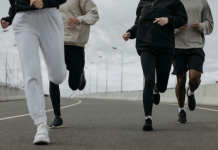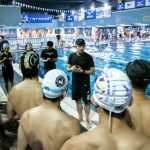文/耐力網/楊志祥
現今訓練法中,不管是跑步、游泳、自行車,這些項目中想要提升能力,在訓練法中絕不缺乏「間歇訓練」,利用較高的強度刺激配合短休息時間,使訓練的選手不斷刺激自己的臨界速度。這種方式,比以往的長時間平穩配速完成一小時的持續運動來得更吸引人,除了這強度比平穩配速來的高外,在練間歇時能與訓練夥伴互相刺激競爭,其中的樂趣更是妙不可言,但是間歇訓練法這麼多種,每種的強度要求與休息時間也不盡相同,對於游泳訓練來說,哪種才是適合鐵人三項選手的呢?
以下為Swim Smooth網站中提到的CSS訓練法,文中針對游泳詳細解釋了強度訓練的方式,以及普遍選手對強度訓練的迷失,讓我們來看看以下文章的重點吧!!
你的游泳訓練週期
Swim Smooth認為任何游泳訓練計畫都要平衡三個元素:「技術」、「體能」與「開放水域的游泳技巧」,每個訓練計畫都應包括這三個要素,但每個人的訓練量會有所調整。你想必很擔心這其中的關係吧?你需要來看看「訓練計畫」(training plans)。
假如你一週有三天可以訓練,我們建議你使用以下排序:
-
技術訓練
-
偏向長距離的耐力訓練
-
處於乳酸閾值的臨界速度訓練
你游泳訓練的質量
對於長距離游泳選手(包含開放水域游泳選手和鐵人三項選手),身體的乳酸閾值數據是最重要的,乳酸閾值提升後,你的速度也將會同時提升。你的衝刺能力與無氧能力跟鐵人三項運動與長泳能力是沒有太大關聯性的,就好像你能舉多重跟你長距離比賽成績並不相關。
訣竅在這裡:想要提升你的乳酸閾值,必須在你在目前的乳酸閾值或是稍低於閾值的速度下進行訓練,許多運動員容易犯的錯是,時常在高於乳酸閾值區間的強度進行距離短的衝刺訓練,這樣的訓練一點都不具有效率,我們將會在下方做出許多解釋。
乳酸閾值/閾值/CSS配速
我們經常將「乳酸閾值」簡稱為「閾值」,兩個詞彙指的是同一件事。在實驗室裡我們在測量乳酸閾值的方式,是檢驗你在游泳運動強度增加時,血液中乳酸濃度突然增加的那一閾值點。雖然這是這是一個能夠準確發現你閾值的做法,但在潮濕的情況下,採血就是一個代價昂貴又艱難的任務。
CSS是「臨界游泳速度」(Critical Swim Speed)的縮寫,這是一個逼近你乳酸閾值的游泳速度,你可以在幾次的游泳測試中測量出來(不需要採血儀器的參與,只需要監控時間),這不是一個完整準確的值,但每100M的誤差能在一秒之內。
在引導你訓練的路上,CSS這個配速值會是一個明確的方向。
尋找CSS配速
CSS檢測需要測驗兩種距離的最佳成績,分別是400M及200M。測量前先做些短的漸速游來讓你的身體活動開。必須先測驗400M,測完四百尺後利用輕鬆遊的方式來做恢復,如此一來就不太會影響到200M的測驗,也能讓你在這兩趟測驗中間能把消耗的體力恢復回來。切記蹬牆出發時不要潛水過長,測驗的結果會比較準確。
盡可能在測試時用盡全力並做好配速,如果找不到別人記錄你每一百的分段時間。你可以只記下總時間,再利用SwimSmooth中的計算器,找出你的CCS。
重要的是在短暫的休息時間內維持一樣的速度。
CSS配速只是方向,讓你的訓練中充滿樂趣,這與你平常的練習配速相比,可能會讓你覺得這個配速稍慢了些,但是休息時間短,是一個不同挑戰。在進行CSS的間歇訓練時,你會覺得第一個100公尺遊起來非常輕鬆,但當你的訓練課程逐漸進行時,「堅持到最後」將會是你腦中最需執行下去的詞彙。
配速節奏的重要性
當你在做CSS訓練時,穩住配速是最關鍵的事,如果你前段速度過快後段放慢下來把時間游到,但這效果還是會打折扣,試著把每趟的速度平均。第一趟100公尺的配速是否穩定,以及之後每一趟的配速能力是區分職業選手及業餘選手的分水嶺。
重新找出你的CSS配速
我們通常都建議每4-6周就測量 400M+200M一次,如果訓練結果順利,每四周做一次的檢測,你就會發現你的能力獲得提升,接著你就必須在CSS課表中在將自己的速度配速提高。
對於多數的鐵人三項訓練選手,我們建議執行三周的扎實訓練,即一周的緩和恢復訓練,最好的CSS測驗時間點為休息週快要結束時。
我不需要游得比我的乳酸閾值還要高的配速嗎?
你相信嗎?你不需要這麼做。
要游得更快這種想法是來自於:「我需要練的比這個配速還要快,我的身體將可以使用這個配速」,這個邏輯是有缺陷的,因為身體不是這麼運作的,當你訓練比閾值還高的速度時,你也同時在破壞你的無氧能力,在長距離的比賽當中你不太需要無氧能力。在訓練結束,你需要提供身體高品質的休息,留下些許的能量來讓身體適應,因此我們才會建議利用適當的訓練配速(CSS)來提升閾值能力,並用它刺激閾值的適應能力,除此之外別無他法。
不相信以上的說法嗎? 把游泳訓練當作重量訓練來看看。假如你想要增加臥舉的最大肌力,你想要將目標放在舉起60KG上,但目前的你只能舉起50KG的重量,能力無法負荷60KG,訓練時做點45-50公斤的重量來讓身體適應及提升,給身體施點壓力藉以提醒它去適應你目前身體能負荷的極限值。
還是不太承認這個訓練法嗎?
來點改變吧!! 嘗試做四周的CSS訓練吧!四周後你會發現你的速度提升了,開始做CSS訓練吧,他就是有這種魔力!!
所以我永遠不需要游得比我的CSS還要快嗎?
所以我永遠不需要游得比我的臨界速度還要快嗎?你絕對需要在訓練課程中安排短衝訓練及無氧訓練,這兩項的訓練有助於提升你的游泳經濟效益,他們能帶給你在水中高速移動的感受和訓練你的神經肌肉反射,如果你現在的訓練有的比例是無氧謊,我們建議你大幅轉到CSS的訓練配速上。這事實上意味著把配速和休息時間放慢及縮短,增加游泳速度的維持能力。
所以訓練中一樣需要做無氧閾值及速度訓練,但要縮短訓練中的比重。
原文出處:Training for Swimming – Maximise Your Speed With CSS / Threshold Work
參考資料:Paul Newsome and Adam Young, Swim Smooth, Chapter 27, Wiley Nautical, 2012
心得:
看完文中所敘述的,了解CSS訓練法的重要性,可以從中了解,與丹尼爾博士在《丹尼爾博士跑步方程式》(Daniels’ Running Formula)中一直強調的T配速的概念相符。這讓我們知道在訓練當中,不只要隨時監控著強度不要過高,還要在訓練課程中安排「無氧閾值」和「短距離衝刺」訓練,其實這些訓練對於一位想要力求進步的鐵人三項選手來說,要完成這些訓練並不難,只需要幾次的嘗試,把自己的配速感抓到,再配合穩定的練習要達到自己要求的秒數可說是手到擒來。
不過,以目前普遍的鐵人選手來說,很容易會被自己的夥伴刺激或是被慫恿,常常都會為了面子,硬是跟上別人的配速,不但訓練到不對的配速,又讓自己身處在受傷的風險裡,可說是贏了面子輸了裡子,最後建議想參照CSS訓練的選手們,拿定自己的配速,持續做訓練一段時間,真的要拼速度的話,比賽再來見真章吧!!!
Your swimming week
Swim Smooth believe that every session you do should have a balance of 3 elements – technique, Fitness and open water specific training. If you are swimming three times a week we suggest you hit this sort of routine:
-
1x Technique orientated session
-
1x Endurance biased session with longer steady paced swim sets
-
1x Quality session working on your threshold speed
Each of those sessions will contain a little of the 3 elements technique/fitness/open water skills, but the amount of each will vary between the sessions.
Worried about getting this right? You need one of our training plans to follow!
your quality swim sets
For distance swimmers – including open water athletes and triathletes – one physiological factor is all important: your lactate threshold. If you can improve your lactate threshold speed your race speeds will improve. Your ability to sprint or work anaerobically above threshold is largely irrelevant in distance swimming and triathlon. So is your ability to lift heavy weights.
Here’s the secret: To improve your lactate threshold you want to do your quality swim sets at your current threshold pace or just below it. Many athletes make the mistake of training above lactate threshold in short sharp swim sets – that isn’t nearly as effective. We’ll explain more about getting that right below.
Lactate threshold, threshold and css
In the training and coaching world we often shorten ‘lactate threshold’ to just ‘threshold’ – it means the same thing. In a laboratory we’d measure your threshold by taking small samples of your blood as you exercise at increasing intensities and look for the characteristic kick up in blood lactate when you reach your threshold swim speed. Blood tests like that are expensive and tricky to perform in a wet environment, fortunately there is a better way to find your threshold speed. Enter CSS.
CSS is an acronym for Critical Swim Speed. It’s an approximation of your lactate threshold speed and you can find it by doing a couple of swimming tests (no blood involved – just a stopwatch!). It’s not precisely the same as lactate threshold but it will be within a couple of seconds per 100m, which is plenty accurate enough to guide your training.
test to find css
The CSS test involves two timetrial swims – a 400m and a 200m. Before attempting these swims perform a thorough warmup and a small build set to get you used to swimming fast.
Do the 400m timetrial first, it’s less likely to effect the 200m than the other way around. Recover completely between each timetrial with some easy swimming. Perform both timetrials from a push off from the wall, not a dive.
Try and pace the trials as evenly as possible, don’t start too fast and slow down. If you’re not sure get someone to take your 100m splits – they can be very revealing.
Calculate your Critical Swim Speed (think threshold speed) using the calculator:
The key point with all these sets is sustained speed with short recoveries. These are just examples, make up your own sessions to keep things interesting.Compared to how you normally train you might find the pace slightly slower but the recoveries much shorter. It’s a different sort of challenge.
CSS feels easy for the first few hundred metres but creeps up on you as the sets go on. The word ‘relentless’ probably describes it best!
the importance of pacing
When you swim CSS sets it’s important to pace things well. If you start too fast and then slow down you won’t get the same training benefit.
Try and swim each repetition at the same pace. Very often this will mean the first few hundred metres feels fairly steady – good pacing technique is an important skill to learn and is one of the key differences between amateur and elite swimmers.
retesting your css
We’d normally suggest repeating the 400+200m CSS test every 4 to 6 weeks. If things are going well then test every 4 weeks because your fitness can improve quite fast and you’ll need to increase the pace of your CSS sets.
For most triathletes we suggest training hard for 3 weeks and then taking an easier recovery week. The perfect time to repeat the CSS test is at the end of the recovery week.
don’t i need to swim faster than my threshold to improve it?
Believe it or not, no you don’t. That line of thinking comes from “I’ll train at this faster pace and my body will get used to it”. That logic is flawed because the body doesn’t work like that. When you train faster than threshold you end up splitting the train effect into your anaerobic system too – which you don’t need much when you race. And you give your body a much greater recovery task after the session, which means it has less energy left over to make the fitness adaptations you are looking for. The result is that training above threshold gives you less adaptation of your threshold,not more.
Not convinced? Compare it to weight training. Say you wanted to increase your maximum bench press. You can currently lift 50kg and want to get to 60kg. You can’t go and lift 60kg – you’re not strong enough. But by doing sets at 45-50kg your body adapts and improves. To stress a body system and prompt your body to adapt you just need to approach your current limit.
Still not convinced? Take the challenge! Try it for 4 weeks, swimming one CSS session per week. Over 4 weeks you’ll notice your speeds improve as the CSS training starts to work its magic.
should i never swim above threshold then?
You certainly can include some anaerobic work and short sprints in your training – they’re good for your swimming technique in themselves: they give you a feel of the water at higher speeds and trains your nervous system to the higher forces. What we’re suggesting is you shift your big training sets away from anaerobic swimming to CSS swimming. In practise this means slowing the pace a touch and shortening the recoveries – making the speed more sustained.
So, still include some anaerobic and sprint work but reduce it and give it less importance in your swimming.
圖片來源:楊志祥、《挑戰自我的鐵人三項》、耐力網
耐力網相信訓練是科學也是藝術,而訓練的藝術,是科學化的極致表現。


.jpg)












